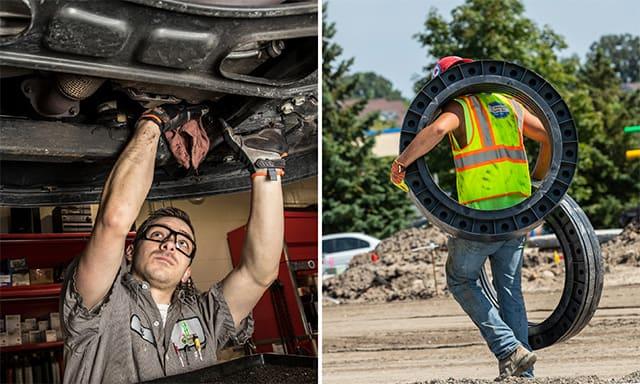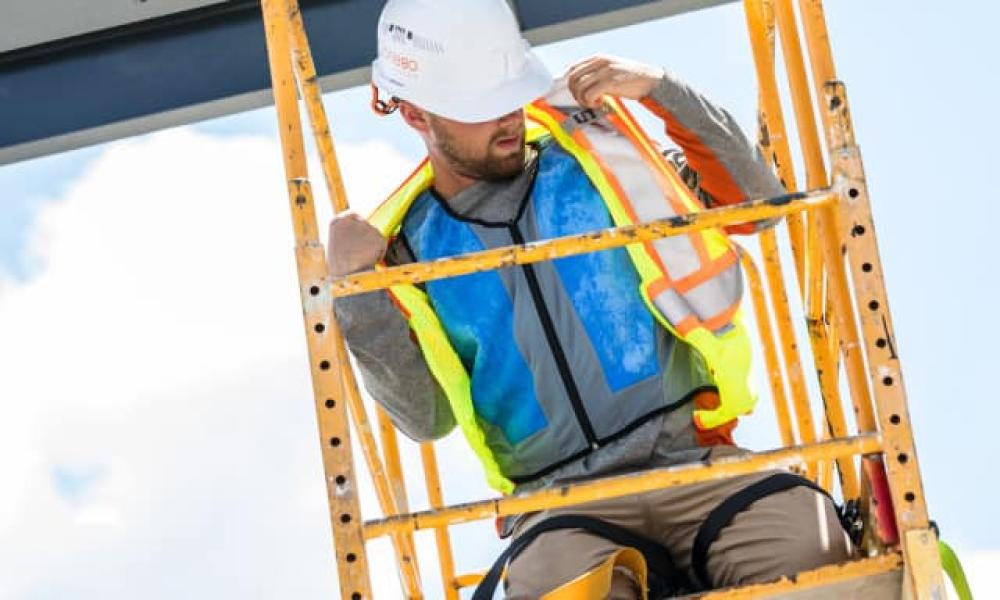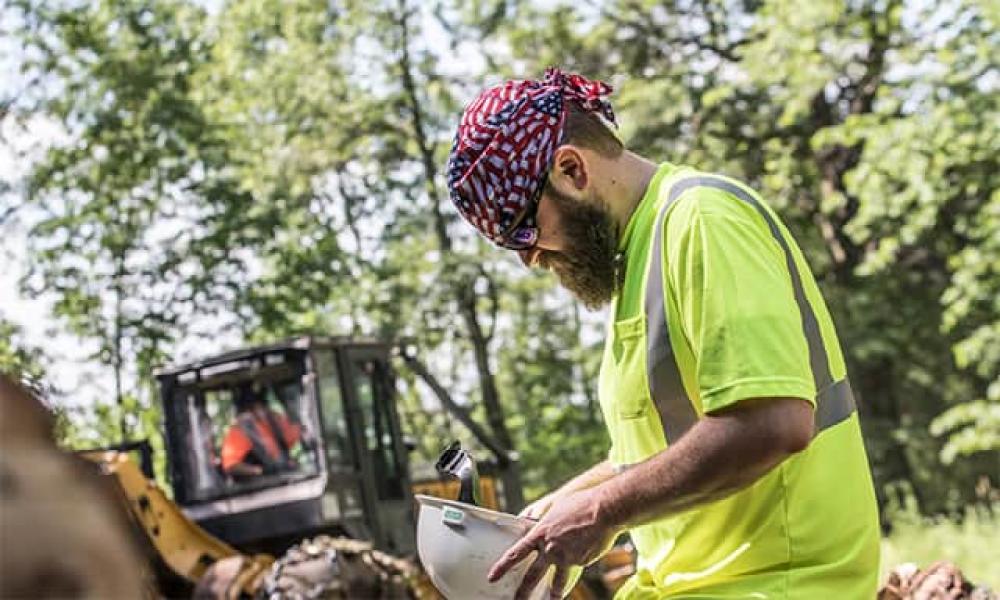Working in the Heat: Outdoor vs. Indoor Heat Stress Prevention Programs

It’s time to face facts—everything on this green earth is getting hotter. 2020 tied the planet’s warmest year ever, joining 18 other record highs set since the turn of the millennium. By 2050, the number of dangerous heat days (a heat index of above 104) across the US is projected to more than double from 20 to 58.
For those regularly bearing the brunt of these temps, these trends are not to be taken lightly. 11 workers are already seriously injured or killed by heat stress every single day—a number that not only includes outdoor workers, but also those who spend 365 days of the year slogging away in foundries, paper mills and other demanding indoor environments. The good news? There’s something we can do to protect them. By developing worksite-specific heat illness prevention plans, safety managers can save lives as soon as today.
WHAT IS HEAT STRESS?
The first step to building the right plan is a basic understanding of what we mean by heat stress. Heat stress illnesses occur when the body fails to keep its internal temperature below 99.7° F (37.6° C). This failure can result in a variety of heat-related illnesses, such as heat rash, heat cramps, heat exhaustion and—most severely— heat stroke. If the internal body temperature climbs to 104°, it only takes 30 minutes to cause cellular damage to the brain or even death.
While this blog focuses on different environmental factors, keep in mind that personal factors such as age, weight, blood pressure and medications also put workers at a greater risk. For a deeper dive into heat stress illnesses , check out our more general Guide to Heat Stress.
What industries are most at risk for heat stress?
If “heat stress on the job” conjures up images of the blistering sun delivering a beat down on sweaty construction workers, you’re certainly not wrong. The Bureau of Labor & Statistics reports that over 95% of these jobs require outdoor work at some point during the day. But the risk goes far beyond construction, with a wide variety of worksites posing a very serious heat stress risk both indoors at out. The following list includes those who have actively participated in OSHA’s Heat Illness Prevention Campaign to educate employers and crews on the dangers of working in the heat:
- Outdoor: Construction, logging, landscaping, agriculture, postal/delivery, fisheries, wildland firefighting, maritime, utilities, railroads, EMTs, oil & gas, sanitation
- Indoor: Warehousing, food processing, foundries, manufacturing, mills, automotive
Outdoor vs. Indoor Heat Stress
Outdoor workers very obviously battle all sorts of elements over the course of a year, with heat stress risks rising as quickly as annual summer temperatures. But it’s not just the heat that safety managers need to consider. The likelihood of developing skin cancer is 3.5 times higher for those who work outdoors than those who do not, making proper skin protection just as crucial to the plan.

Not to be outdone by it’s fresh air counterpart indoor work can pose just as much of a heat stress risk (and sometimes even more). While a lack of air conditioning or general airflow can turn any indoor worksite into a sweat lodge heat is a perpetual danger in environments like foundries, refineries, welding shops and mills. This risk is often further exacerbated by the requirement of heavy-duty PPE such as welding helmets, coveralls or hazmat suits.

HEAT STRESS PREVENTION: COOLING TECHNOLOGIES & GEAR
OSHA’s “Water. Rest. Shade.” is just the start. A complete heat stress prevention program goes beyond the basics to provide workers with convenient and comfortable solutions that not only keep workers shaded and hydrated, but employ advanced cooling technologies to keep them safe outdoors and in.
Evaporative Cooling Technologies
Best for: Outdoor work in hot and dry environments with low/moderate humidity (construction, maintenance, landscaping, etc.)
Evaporative cooling products are a simple and relatively inexpensive way to keep internal temperatures easy breezy. Evaporative solutions activate with water, working similarly to how sweat cools the body by drawing heat away from the body. More advanced and comfortable than a damp towel, controlled evaporative gear keeps workers cool for up to four hours once activated.
SEE EVAPORATIVE COOLING SOLUTIONS
Phase Change Cooling Technologies
Best for: Indoor work in hot environments (foundries, pulp/paper, iron/steel, fabrication, etc.)
Phase change cooling technology does not require airflow, making it an optimal solution for reducing the risk of indoor heat stress . Commonly used in vests, this technology pulls heat from the body via cooling charge packs filled with non-toxic phase change liquids. Depending on what you have available (cooler, fridge or freezer), activation takes between 10-25 minutes and lasts up to four hours. Unlike ice or gel packs, phase change packs are not stiff or frosty—making them a more comfortable solution for long term wear, especially underneath bulky PPE.
SEE PHASE CHANGE COOLING SOLUTIONS
Absorptive Cooling Technologies
Best for: Indoor or outdoor work in hot environments (construction, maintenance, manufacturing, etc.)
You can’t stop sweat, but you can prevent it from hazardously running into your eyes and down your hands. Absorptive products like cooling towels, headbands and multi-bands sop sweat to keep workers cool and dry.
SEE ABSORPTIVE COOLING SOLUTIONS
Hydration
Best for: Indoor or outdoor work (construction, maintenance, manufacturing, etc.)
Dehydration puts workers on a fast track to any one of the many heat-related illnesses. OSHA mandates access to fresh water on every jobsite, but that access should be as close to immediate as possible in hot environments.
Shades & Shelters
Best for: Outdoor work in hot, sunny environments (construction, maintenance, landscaping, etc.)
This is where that whole rest and shade thing comes in. When natural shade isn’t readily available, pop-up shelters and umbrellas provide instant relief from the baking sun. When it’s not possible to shade the designated working area (and it often isn’t), outfit workers with sun protection hats, UV rated clothing and sunglasses for more complete all-day coverage.
Sunscreen
Best for: Outdoor work in sunny environments (construction, maintenance, landscaping, etc.) or indoor work where welding equipment is used
No burning here, baby. Regular application of sunscreen on the jobsite is perhaps the easiest and most cost effective way to stop skin cancer in its tracks. Thought sunscreen was just for the great outdoors? Think again. Though inside, welders are regularly exposed to dangerous levels of UV rays and should take the same skin protection precaution.
START BUILDING YOUR HEAT ILLNESS PREVENTION PROGRAM
Don’t save it for a sweltry day. By the time the scorch hits, it could be too late. Whether indoors or out, understanding your worksite’s temperature risks and implementing a comprehensive heat illness prevention plan to mitigate them can literally save lives as the mercury rise(s).
Heat stress is caused by hot environments both indoors and outdoors. Outdoor environment factors include high temperatures and sunny conditions, while indoor environments can be due to a lack of airflow. Other factors include strenuous physical activities, direct sunlight, high humidity, working with hot equipment and having heat reflected off the ground or objects. Heat stress can be exacerbated by the requirement of heavy-duty PPE such as welding helmets, coveralls or hazmat suits.
Heat stress illnesses occur when the body fails to keep its internal temperature below 99.7° F (37.6° C). If the internal body temperature climbs to 104°, it only takes 30 minutes to cause cellular damage to the brain or even death.
Outdoor: Construction, logging, landscaping, agriculture, postal/delivery, fisheries, wildland firefighting, maritime, utilities, railroads, EMTs, oil & gas, sanitation.
Indoor: Warehousing, food processing, foundries, manufacturing, mills, automotive.
A lack of air conditioning or general airflow can turn any indoor worksite into a heat stress hazard. This can be common in environments like foundries, refineries, welding shops and mills.
OSHA’s “Water. Rest. Shade.” initiative is just the start. A complete heat stress prevention program goes beyond the basics to provide workers with convenient and comfortable solutions that not only keep workers shaded and hydrated, but employ advanced cooling technologies to keep them safe outdoors and in.
Staying hydrated is a key factor in preventing heat stress. OSHA recommends drinking 8oz of water every 20 minutes while working in the heat. It is also important to ensure all workers are trained on the signs and symptoms of heat-related illnesses and to participate in the buddy system. Evaporative cooling products are a simple and relatively inexpensive way to help prevent heat stress. Evaporative solutions activate with water, working similarly to how sweat cools the body, by drawing heat away from the body for up to four hours once activated.







